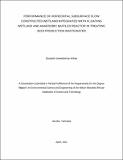Performance of horizontal subsurface flow constructed wetland integrated with floating wetland and anaerobic baffled reactor in treating seed production wastewater
Abstract
Discharge of untreated or partially treated industrial wastewater is the major contributor to aquatic
environmental pollution. Seed producing industrial wastewater is composed of high organic
matter, nutrient, and suspended solids. Discharging inadequately treated seed production
wastewater can cause severe environmental pollution because of high nutrients and organic matter
in the wastewater. The performance of integrated wastewater treatment system composed of
anaerobic baffled reactor (ABR), horizontal subsurface flow constructed wetland (HSSFCW), and
floating constructed wetland (FCW) for removal of pollutants from seed production industrial
wastewater was studied. In HSSFCW, Cyperus alternifolius were planted with four rhizomes in
each square meter, and the FCW had four floating mats made from polyethylene foam planted
with Vetiver grass. The wetlands were continuously fed from ABR receiving 25 m
3
/day
wastewater from wastewater reservoir. The raw wastewater average organic loading rate was 0.208
kg COD/day. Wastewater samples from the inlet and outlet of each treatment unit were collected
twice a week for three months. The performance of the system in removal of biochemical oxygen
demand (BOD
5
), chemical oxygen demand (COD), total suspended solids (TSS), turbidity, nitrate,
phosphate, and ammonium were studied. The results showed that the system achieved an average
removal efficiency of 95.52%, 94.57%, 86.23%, 76.56%, 82.35%, 76%, and 32.91% for BOD
5
,
COD, TSS, turbidity, nitrate, phosphate, and ammonium respectively. Based on the results
obtained the integrated system composed of ABR, HSSFCW, and FCW is a promising low-cost
technology for treating wastewater from seed producing industries, and the treated wastewater can
be used for irrigation.

